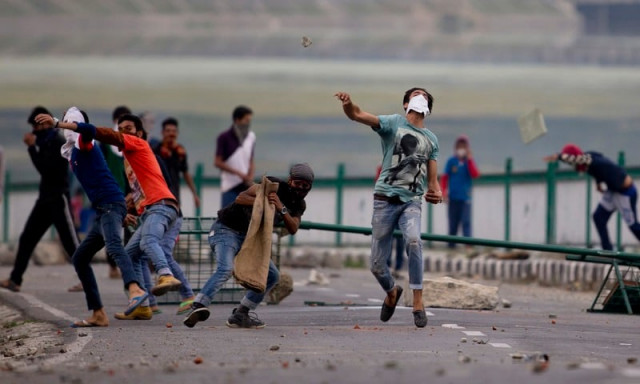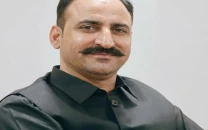Deadly injuries show why pellet guns must be banned in Kashmir
105 cases of pellet injuries received on day of Wani's death, a number doctors claim is highest ever in one day

PHOTO: AP
PM convenes cabinet meeting to discuss situation in held Kashmir
Pellet guns, introduced in 2010 to quell protests, have been regularly used by law enforcement agencies in the valley, resulting in the deadliest and most lethal injuries caused to civilians.
On Sunday, similar tragedy befell 20-year-old Shabir Ahmad who was sitting with his friends on a road outside his home in Kashmir's Pulwama district.
 PHOTO: SachTimesNews
PHOTO: SachTimesNews"A protest was going on at some distance away from me. Some youths were pelting stones on police. Suddenly, I felt a spray of hot iron particles piercing my body. It all went dark in a flash," Shabir, who was taken to a local hospital by his friends, told ScoopWhoop.
Doctors observed that the tissue of Shabir's right eye had been damaged due to the pellets. For him, and dozens others who are grievously injured due to the use of pellet guns, life might never be the same again.
Shabir's is one of the 105 cases of pellet injuries received by the valley's Shri Maharaja Hari Singh Hospital (SMHS) since the army killed Hizbul Mujahideen (HM) leader in an encounter on Friday.
Pakistan condemns India's killing of Hizbul Mujahideen commander in occupied Kashmir
"I haven't seen such a huge number of eye injuries in a single day during my entire career. It does not happen even in Gaza," a senior doctor from Department of Ophthalmology at SMHS hospital said.
"Our team of 30 doctors conducted 87 surgeries in 48 hours. That's never happened in the history of Ophthalmology," the doctor, who was not authorised to speak to the media, said. According to Radio Pakistan, a senior doctor at the SMHS Hospital said two of the victims may lose their eyesight forever.
https://twitter.com/_Faysal/status/752758416716750848
The cartridge of pump action shotgun or pellet gun are small iron ball bearings which are sprayed out towards a target when fired with high velocity, piercing a human body at dozens of spots. Even though the government maintains that weapons are 'non-lethal', human rights groups and experts have called such claims "inherently inaccurate and indiscriminate" after dozens of Kashmiri youth lost their vision or were left half-blind due to the pellet guns.
 PHOTO: REUTERS
PHOTO: REUTERS"The eye is like a water balloon. If a pellet enters an eye and gets out from the other side, the eye is totally damaged. In case of struck iron ball bearings in the eye, the eye can be saved but we can't guarantee that the vision will be restored," the senior Ophthalmologist at SMHS explained.
Nawaz deplores Indian oppression as Kashmiri anger boils over
"I can only see a shadow and nothing else," 15-year-old Basit said from his bed at SMHS hospital where he's recovering. "They fired pellets on us from a distance of 12 feet."
There are many who have demanded that the use of pellet guns by the police and CRPF must be banned as it in not in line with international standards on the use of force. But for the moment, they stay in use and so do the scars.



















COMMENTS
Comments are moderated and generally will be posted if they are on-topic and not abusive.
For more information, please see our Comments FAQ